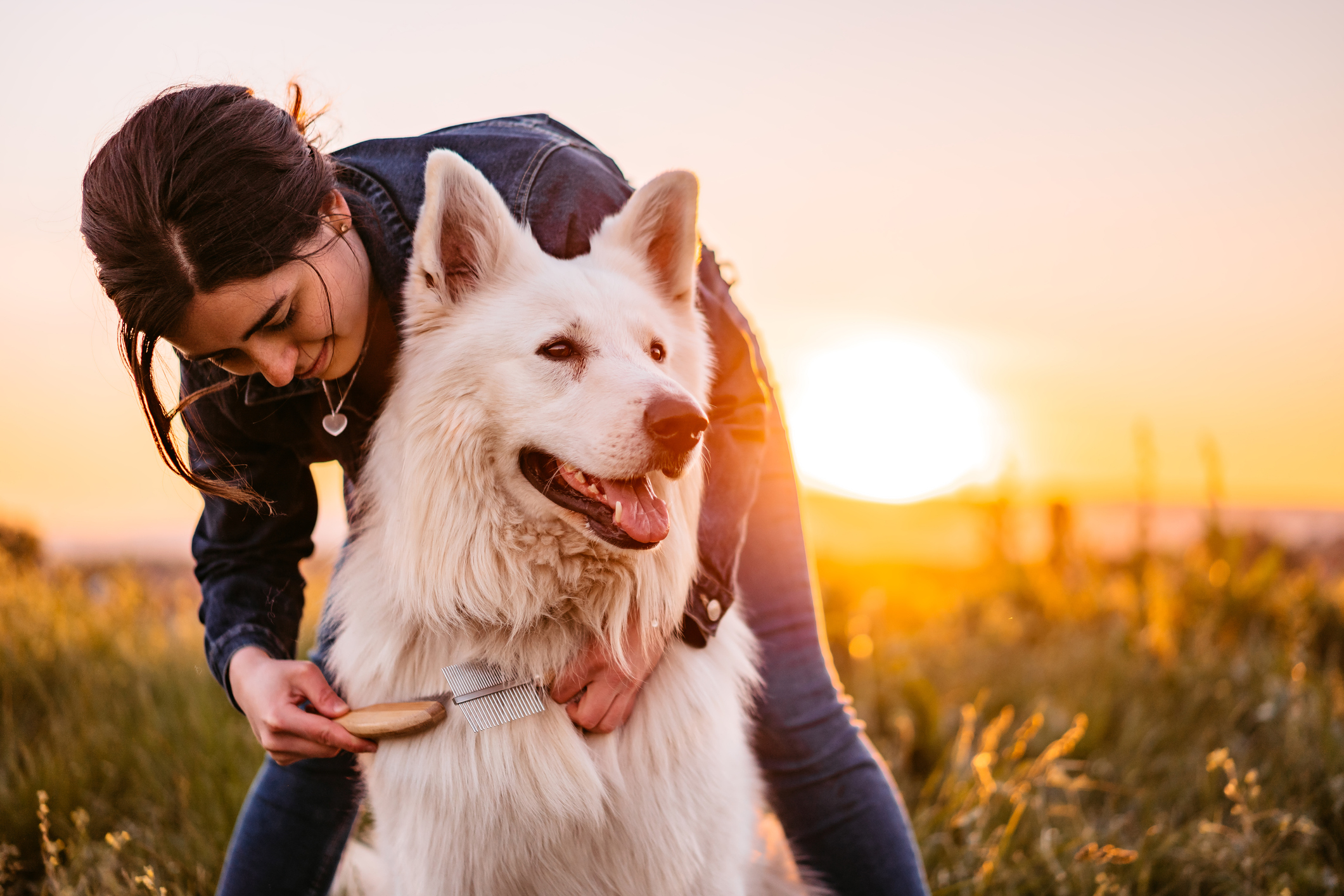Does Your Dog Have Dandruff? Here’s What to Do.

We all know how dandruff can make us feel uncomfortable and unattractive. The last thing you’d want is for your dog to develop the same skin problem.
You may not have stopped to think about it, but the truth is that just like humans, dogs too can (and do) develop dandruff at some point or the other. Dog dandruff can range from mild dryness to severe flakiness that is not only painful for your pet, but also prone to getting infected.
Knowing the right tips for treating dog dandruff will help you maintain your furry friend’s coat in top condition. But how do you know for sure that it’s actually dandruff and not just skin dryness due to the weather conditions?
The following section will help you figure it out.
What Is Dog Dandruff?
Dog dandruff, known as seborrhea, is a skin condition in canines that causes white scales. These can turn red and itchy, and if left untreated for a considerably long period of time, it can develop into secondary skin infections.
Dog dandruff can be of two types: oleosa (oily seborrhea) and sicca (dry seborrhea). A majority of dogs usually show symptoms of both dry and oily seborrhea.
Seborrhea is a genetic disorder, which means that your pet might be prone to it by birth. However, there are various other factors that can trigger the onset of dog dandruff too. For instance, parasites, bacterial growth, dietary deficiencies, and certain health problems like autoimmune disorders can lead to this skin problem in dogs.
How to Identify Dog Dandruff
Common symptoms of seborrhea include:
• Greasy skin
• Visible flakes or dander
• Red patches on the head or different parts of the body, especially under the belly, around the ankles, and folds of skin
• Hair loss
Dogs with seborrhea often have a foul smell coming off them. This is due to the buildup of oil on their skin and hair.
Failing to take the proper steps for treating dog dandruff can worsen the problem for your pet as they are likely to scratch and lick it, increasing the risk of infection even further.
Tips for Reducing Dog Dandruff
Bathe Your Dog Regularly
In most cases, giving your pet a proper bath regularly might be all it takes to get rid of their dandruff once and for all. This is especially true for dogs that are somewhat hydrophobic, or in the case of dog owners who only bathe their pets occasionally.
Dogs generally need to be bathed once every two weeks. Bathing them more or less frequently than this can cause changes in the pH level of their skin which eventually leads to issues like dandruff.
When giving your pet a bath, make sure that the water is not too hot. You should always use lukewarm water. Higher water temperatures can damage the skin cells which, in turn, lead to dryness as their skin is unable to retain moisture.
Use a Dandruff Shampoo
One of the most common mistakes many pet parents make is to use their own dandruff-control shampoo for treating their dog’s dandruff. Never ever bathe your pet using a shampoo made for people.
There are various moisturizing dog shampoos and conditioners available at pet shops. You should use them for cleaning your dog’s fur instead. You can also buy products specially formulated for dogs with dandruff issues.
Watch Out for Weather Changes
One of the best tips for treating dog dandruff is to keep an eye on weather changes. If dry skin and increased pet dander often coincide with dry weather or similar seasonal changes, it’s obvious that your pet’s dandruff is a result of the environmental impact.
If you live in a cold region where the humidity levels are usually low, your pet’s skin is bound to be more susceptible to seborrhea.
Keep Your Dog Well Hydrated
Many dogs get dandruff because of low water intake. Therefore, you need to ensure that your pet drinks a sufficient amount of water every day.
If your dog drinks plenty of water but still has dry skin, try adding high-quality fresh or wet foods to their daily diet. These foods have a rich moisture content that not only helps keep your pet well hydrated but also promotes digestion and nutrient absorption to boost skin health.
Change Your Dog’s Diet
If your dog’s dandruff is a result of dietary deficiencies, it goes without saying that no amount of external care will help solve the problem. You need to change their diet so that they get all the nutrients that their body requires.
However, changing your pet’s meal plan does not necessarily mean switching from one pet food brand to another. You might have to talk to an expert animal nutritionist instead. They will take into account your dog’s breed, age, size, activity level, and other factors before deciding on a proper meal plan.
Try Dog Supplements
In addition to changing your dog’s diet, you should also consider giving them pet supplements. This will help in truly conditioning your pooch’s skin from the inside out.
Omega fatty acids have many benefits for improved skin health in humans and dogs alike. Some of the best pet supplements that can help with dandruff issues include salmon oil, flaxseed oil, and coconut oil. They are a rich source of omega 3 and 6 fatty acids that can help eliminate dandruff by targeting it at the cellular level.
End Note
Follow these tips for treating dog dandruff to support your pooch’s skin and coat health. However, for treating dog dandruff, you should not rely on at-home care only.
Dandruff is not normal and needs to be dealt with properly before it progresses into something more dangerous.
If your canine companion has been lately scratching themselves quite excessively or you have already noticed visible flakes or pet dander around the house, it’s best to book an appointment with your vet immediately.
